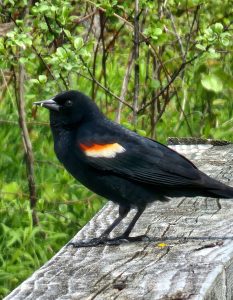 Even many non-birders are familiar with Red-winged Blackbirds. They breed in wet areas including cattail marshes and roadside ditches, and, as their name indicates, they’re black with red (and yellow) epaulets on their shoulders. Their song is a loud “o-kra-lee!”
Even many non-birders are familiar with Red-winged Blackbirds. They breed in wet areas including cattail marshes and roadside ditches, and, as their name indicates, they’re black with red (and yellow) epaulets on their shoulders. Their song is a loud “o-kra-lee!”
We’re hearing from you that there seems to be more red-wings around this year than other years. No online resources are indicating this, but most species’ populations go through cycles of greater or lesser abundance for many reasons, including food abundance, habitat availability, predator populations, etc. For example, if food was abundant where they overwintered last year, more may have survived the winter to return this spring. Or perhaps their nest predator abundances are lower this year and more young survived.
Regardless, we can expect to see an increase in their numbers locally as summer progresses. Their breeding season is over, or close to it, and the blackbirds will begin to gather in very large flocks before they head south for the winter.
eBird Canada, a citizen-science database housed at Cornell University in Ithaca, New York and managed in Canada by Birds Canada and Québec Oiseaux, as a lot of really cool interactive tools to explore species’ abundances, movements, etc. If you’d like to explore how Red-winged Blackbird average abundance changes throughout the year, click that hyperlink, zoom into our area on the interactive map, and click the right arrow under the two bars to see how their abundance changes in weekly increments. You’ll see they typically arrive in Peterborough around March 1st, and that their numbers will increase around here again as late-July moves into August.
If you’re seeing them at your feeders, you might be wondering how to discourage them. In short, we can’t, really. They can fit their beaks in the Nyger feeders that typically exclude some of the other large “feeder bullies,” like Blue Jays, Common Grackles, European Starlings, and Brown-headed Cowbirds. So, sit back and enjoy their beauty before they head south 🙂
Photo credit: Red-winged Blackbird, Miller Creek, Chris LaForce. Thank you!
